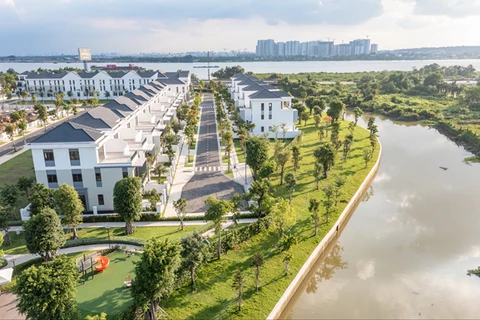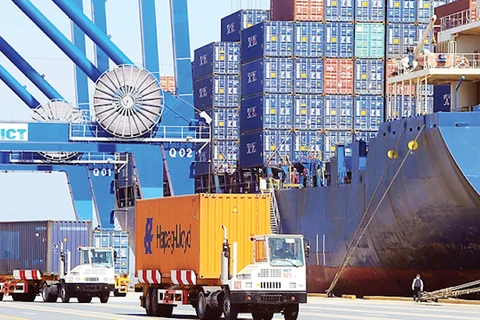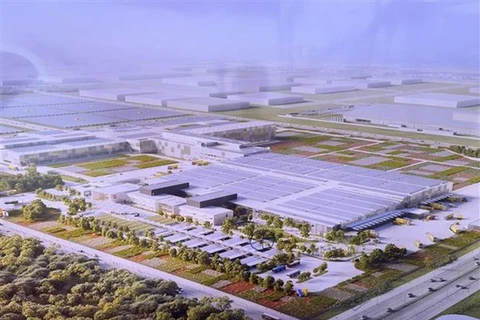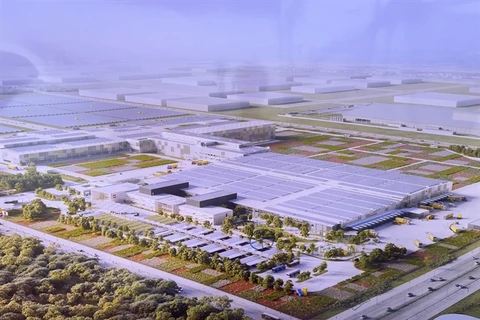Hanoi (VNA) – Textile and garment businesses in Vietnam are taking steps to switch to green production to meet partners’ demand and achieve sustainable development, the Cong Thuong (Industry & Trade) newspaper reported.
Greening textile and garment production chains is currently a global trend that are compulsory for businesses to achieve sustainability. It is also a requirement placed on manufacturers as the EU, which imports over 4 billion USD worth of textiles and garments from Vietnam annually, has proposed the imposition of some eco-regulations on imports.
Major fashion brands in the world are also prioritising green enterprises to place their orders or requesting suppliers to adopt green practices.
Facing challenges and strict requirements from the market, many Vietnamese businesses are making changes towards green manufacturing, including upgrading factories and using recycled fabric and green energy.
Among them, the Hanoi Textile & Garment Joint Stock Corporation (Hanosimex) and the Hansae group of the Republic of Korea are implementing a recycled fabric production project in Vietnam.
Hansae Deputy General Director K. Kim said the two enterprises will be the first in Vietnam’s textile and garment industry to make a historic turning point with the formation of a complete supply chain, from yarn making, weaving, dying to sewing, particularly for recycled products.
They will produce yarn and fabric from recycled fibre in Vietnam, and all of those products will be used to produce garment for export. About 4,000 tonnes of recycled fabric will be manufactured for the EU market in the coming time, he noted.
Le Tien Truong, Chairman of the Vietnam National Textile and Garment Group (Vinatex), said developing a circular economy and environmentally friendly products is now a trend in the global textile and garment market. From now to 2050, the EU will issue new rules on textile and garment products, with a focus on green ones.
He held that the strategic cooperation between Hanosimex and Hansae will help the two sides increase the proportion of recycled, green, and eco-friendly items.
Vinatex has invested in new technology to reduce 30% of wastewater discharged from the dying process and reuse 30% of treated wastewater. It also aims to use reneable energy for 10% of its power consumption.
In the Mekong Delta province of An Giang, the Danish-invested Spectre garment factory, which specialises in producing outdoor sport clothing for export, will be partly fueled by renewable energy.
The 17 million USD factory, the third plant of Spectre in Vietnam, has been granted the LEED (Leadership in Energy and Environmental Design) certification.
With a modern design and the use of solar power, it is able to reduce some 1,600 tonnes of CO2 emitted each year./.
Greening textile and garment production chains is currently a global trend that are compulsory for businesses to achieve sustainability. It is also a requirement placed on manufacturers as the EU, which imports over 4 billion USD worth of textiles and garments from Vietnam annually, has proposed the imposition of some eco-regulations on imports.
Major fashion brands in the world are also prioritising green enterprises to place their orders or requesting suppliers to adopt green practices.
Facing challenges and strict requirements from the market, many Vietnamese businesses are making changes towards green manufacturing, including upgrading factories and using recycled fabric and green energy.
Among them, the Hanoi Textile & Garment Joint Stock Corporation (Hanosimex) and the Hansae group of the Republic of Korea are implementing a recycled fabric production project in Vietnam.
Hansae Deputy General Director K. Kim said the two enterprises will be the first in Vietnam’s textile and garment industry to make a historic turning point with the formation of a complete supply chain, from yarn making, weaving, dying to sewing, particularly for recycled products.
They will produce yarn and fabric from recycled fibre in Vietnam, and all of those products will be used to produce garment for export. About 4,000 tonnes of recycled fabric will be manufactured for the EU market in the coming time, he noted.
Le Tien Truong, Chairman of the Vietnam National Textile and Garment Group (Vinatex), said developing a circular economy and environmentally friendly products is now a trend in the global textile and garment market. From now to 2050, the EU will issue new rules on textile and garment products, with a focus on green ones.
He held that the strategic cooperation between Hanosimex and Hansae will help the two sides increase the proportion of recycled, green, and eco-friendly items.
Vinatex has invested in new technology to reduce 30% of wastewater discharged from the dying process and reuse 30% of treated wastewater. It also aims to use reneable energy for 10% of its power consumption.
In the Mekong Delta province of An Giang, the Danish-invested Spectre garment factory, which specialises in producing outdoor sport clothing for export, will be partly fueled by renewable energy.
The 17 million USD factory, the third plant of Spectre in Vietnam, has been granted the LEED (Leadership in Energy and Environmental Design) certification.
With a modern design and the use of solar power, it is able to reduce some 1,600 tonnes of CO2 emitted each year./.
VNA

























